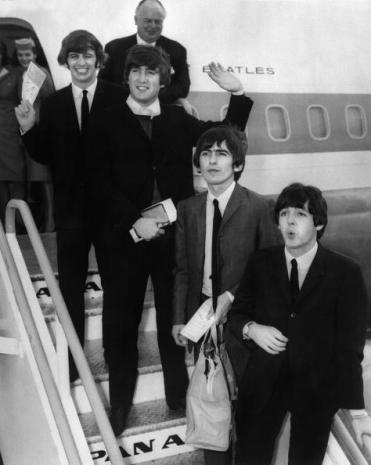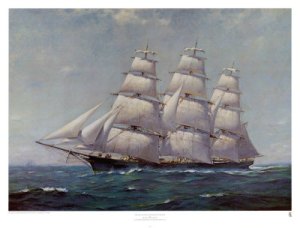Pan Am Series – Part XLV: The Boeing 707 – 2
12 October 2014 1 Comment
The Boeing 720B
With the launch of the Jet Age with its 707-100 series, Boeing soon found itself at a competitive disadvantage with Douglas, who already had an established world-wide network of agents, representatives and salesmen to market its DC-8 jet. To counter this, according to Ron Davies in Pan Am – An Airline and Its Aircraft, Boeing produced what it called “a family of airliners, focusing on the commonality of parts between the various models”. Davies also noted that “although this did not look like a family until the Boeing 727 was launched in 1963, the idea was nevertheless effective, even though the 707s seemed to look the same”. According to Davies, Boeing “made much of its willingness to meet a customer’s precise requirements, whereas Douglas was inclined to be more rigid, offering a choice of DC-8 series but reluctant to deviate from the basic specifications of each series.”
Out of this came the Boeing 720.
As described in its website, while the 707-100 series was being introduced and the long-range 707-300 series was being planned, Boeing also decided to develop a 707 derivative with increased performance for short-to-medium range routes, allowing the plane to operate from shorter runways. Initially the plane was identified as the 707-020, was later changed to 717-020 and, with input from launch customer United Airlines, was eventually designated the 720.
Outwardly the model 720 resembled the 707, but it was a very different airplane. It had a much lighter structure and was 9 feet (2.74 meters) shorter than the 707-100. It also had an increased wing sweep on the leading edge between the fuselage and inboard engines as well as full-span Krueger leading edge flaps. The 720 carried less fuel than the 707-100. Combined with its lighter structure, this gave the plane a lower gross weight, increased takeoff performance and a higher top speed.
The 720 went into service on 5 July 1960 with United Airlines. Boeing built 65 model 720s. The only variant of the 720 was the 720B which first flew on 6 October 1960. The main difference on the 720B was the installation of Pratt and Whitney JT3D Turbofan engines that increased the takeoff and climb performance as well as cruise speed of the plane. These engines also increased the range to 4000 miles, which, for a short time, was the longest range for any commercial airliner. Boeing built a total of 89 720Bs.
Pan American operated nine 720Bs, delivered between 1963 and 1965. They were mainly used in the Caribbean and Latin America and were eventually disposed of by 1974.
The 720 proved to be an economical plane to operate and was a favorite of pilots, passengers and operators alike. However, the rapid pace of technology soon caught up with it as the more capable 727 replaced the 720 as the leader in the medium-range, high-performance market.
The Boeing 707-321
“One of the Great Airliners of All Time”
In his seminal book, Pan Am – An Airline and Its Aircraft, Ron Davies referred to the Boeing 707-320 Series as “one for the great airliners of all time”. While this airliner may have later been overshadowed by her bigger and more powerful sisters, this statement remains true. Pan American began taking deliveries of the Boeing 707-321 (-321 indicated Pan American service) in 1959. However, the impact of the aircraft was really felt during the following decade.
The 1960s, in particular the years 1963-1968, represented the pinnacle of Pan American’s success. Pan American dominated the international airline arena like no other airline during that decade, a period when the volume of air traffic quadrupled.
During that time, Pan American could do no wrong. By the middle of 1962, it was the first airline to complete 100,000 transatlantic flights, a figure, according to Davies, “not even approached by any other airline at that time”. On 7 March 1963, Pan American moved into a new building that towered over Grand Central Station in New York City, with the “Pan Am” abbreviation in huge letters on the top, visible for miles up and down Park Avenue. As Robert Daley said, in An American Saga, “The once tiny airline had become the world’s biggest and most famous”.
In the airline’s 1965 Annual Report, it was announced the retirement from regular service the last of its piston fleet, making Pan American an “all-jet airline”. The 1967 Annual Report, which, by some accounts, detailed Pan American’s most successful year in its history, highlighted the delivery of 32 jet aircraft in 1967 with an additional 31 “present generation jets” on order for delivery in 1968-69 and announced airline’s $600,000,000 order for 25 Boeing 747 “Superjets”, and in doing so, “led the industry to a new generation of heavy duty transports”. It was also announced that “Pan Am will be the first American-flag airline to operate [Anglo-French Concorde] supersonic jets”, while also reserving “substantially more delivery positions for American SSTs than any other airline”. The report also noted that “Pan Am made the first fully automatic approach and landing in scheduled service” and in the year since, has “completed over 100 of these approaches and landings”.
The Boeing 707-321 was in the center of it all. It flew everywhere on Pan American’s routes, and all together 120 of this variant were operated, in addition to the eight 707-121’s and nine 720B’s.
The 707-300 series had a longer fuselage, bigger wings and higher-powered engines. With these improvements, which allowed increased fuel capacity from 15,000 gallons to more than 23,000 gallons, the 707 had a truly intercontinental range of over 4,000 miles in a 141-seat (mixed class) seating configuration. The aircraft was later fitted with Pratt & Whitney JT3D turbofan engines that provided for lower fuel consumption, reduced noise and further increased its range to about 6,000 miles.
The 707 quickly became the most popular jetliner of its time, and its popularity led to rapid developments in airport terminals, runways, airline catering, baggage handling, reservations systems, and other air transport infrastructure. The advent of the 707 also led to the upgrading of air traffic control systems to prevent interference with military jet operations.

Boeing 707-321B, Clipper Gem of the Skies, at New York Kennedy Airport (Peter Black, courtesy of Jon Proctor)
Below is the cover, inside cover, round-the-world schedules and route map from the September 1967 timetable. This is a small example of the extent of Pan American’s operations in the 1960s.
As the 1960s drew to a close, the exponential growth in air travel led to the 707’s being a victim of its own success. The 707 was now too small to handle the increased passenger densities on the routes for which it was designed. Stretching the fuselage was not a viable option because the installation of larger, more powerful engines would in turn need a larger undercarriage, which was not feasible given the design’s limited ground clearance. The answer to the problem was the first twin-aisle airliner—the Boeing 747. The 707’s first-generation engine technology was also rapidly becoming obsolete in the areas of noise and fuel economy, especially after the 1973 oil crisis.
The Boeing 707 brought Pan American to the highest levels of international commercial aviation. It made international travel accessible to more and more travelers and was seen in all corners of the globe. It was, to many of Pan American’s pilots and flight attendants, their favorite airliner, and is cherished in their memories.
Pan American’s Boeing 707’s in their final resting place. (Andrew Thomas)
For additional information about Pan American World Airways:
To learn more about the history of this pioneering airline, click on the title below for preview of
Pan American World Airways – Images of a Great Airline Second Edition.
This book is available on eBay .
Another excellent book is Pan Am – Personal Tributes to a Global Aviation Pioneer, which was published to commemorate the 90th Anniversary of Pan Am’s founding. It contains more than 80 stories written by former Pan Am employees and international media friends who had personal experience with many of Pan Am’s key events during its history. It is the perfect companion to Pan American World Airways – Images of a Great Airline Second Edition and can be purchased on Amazon.
Preview Pan American World Airways – Aviation History Through the Words of its People, which is available on Amazon.
For further information about the history of Pan American World Airways, visit: Pan Am Historical Foundation













































































































































































































Recent Comments